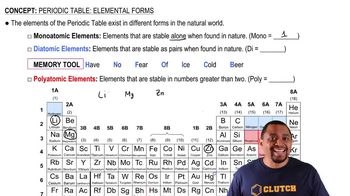Here are the essential concepts you must grasp in order to answer the question correctly.
Ionization Energy
Ionization energy is the energy required to remove an electron from a gaseous atom or ion. It is a key indicator of how strongly an atom holds onto its electrons. Generally, ionization energy increases across a period in the periodic table due to increasing nuclear charge and decreases down a group due to increased distance from the nucleus and electron shielding.
Recommended video:
Periodic Trends
Periodic trends refer to the predictable patterns observed in the properties of elements as you move across or down the periodic table. For ionization energy, elements on the right side of the table (like bromine) typically have higher ionization energies than those on the left (like bismuth) due to their greater effective nuclear charge and smaller atomic radius.
Recommended video:
Comparison of Elements
When comparing elements, it is essential to consider their positions in the periodic table. Bromine (Br) is located in Group 17 and Period 4, while bismuth (Bi) is in Group 15 and Period 6. The difference in their groups and periods influences their ionization energies, with Br expected to have a higher ionization energy than Bi due to its smaller atomic size and higher electronegativity.
Recommended video:
Elemental Forms of Elements
 Verified step by step guidance
Verified step by step guidance


